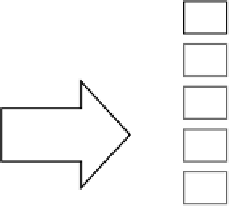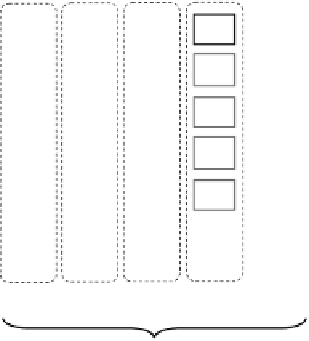Information Technology Reference
In-Depth Information
n
1
overflows while
n
4
underflows.
v
0,0
v
0,1
v
0,3
v
0,2
v
0,0
v
0,1
v
0,3
v
0,2
v
1,3
v
1,0
v
1,1
v
1,2
v
1,2
v
0,4
v
1,0
v
1,1
v
2,0
v
2,2
v
2,1
v
2,3
v
1,3
v
2,0
v
1,4
v
2,1
Re-indexing
v
3,1
v
3,0
v
3,2
v
3,3
v
2,3
v
2,2
v
2,4
v
3,0
v
4,0
v
4,1
v
4,3
v
4,2
v
3,1
v
3,2
v
3,4
v
3,3
.
.
.
.
.
.
.
.
n
0
n
1
n
2
n
3
n
4
n
0
n
1
n
2
n
3
Original block indices (4 nodes)
New block indices (5 nodes)
Figure 15.3
Re-indexing the first group of media data blocks
n
1
overflows while
n
4
underflows.
Block
v
0,4
is moved from
n
1
to
n
4
.
v
0,0
v
0,1
v
0,3
v
0,2
v
0,0
v
0,1
v
0,3
v
0,2
v
0,4
v
1,2
v
0,4
v
1,0
v
1,1
v
1,2
v
1,0
v
1,1
v
1,3
v
2,0
v
1,4
v
2,1
v
1,3
v
2,0
v
1,4
v
2,1
Re-organize
v
2,3
v
2,2
v
2,4
v
3,0
v
2,3
v
2,2
v
2,4
v
3,0
v
3,1
v
3,2
v
3,4
v
3,3
v
3,1
v
3,2
v
3,4
v
3,3
.
.
.
.
.
.
.
.
n
0
n
1
n
2
n
3
n
4
n
0
n
1
n
2
n
3
n
4
Group 0 before reorganization
Group 0 after reorganization
Figure 15.4
Reorganizing the first group of media data blocks
Since we do not need to maintain the strict round-robin placement order under RPDR, we
can simply move the excess block from the overflow node to the underflow node. For example,
we move data block
v
0
,
4
from node
n
1
to node
n
4
as shown in Figure 15.4 to restore the
streaming load balance of the new 5-node configuration.
As a further illustration, we consider the second group of data blocks in Figure 15.5. Now
there are two overflow nodes
n
0
and
n
2
, as well as two underflow nodes
n
1
and
n
4
. To restore
































Search WWH ::

Custom Search